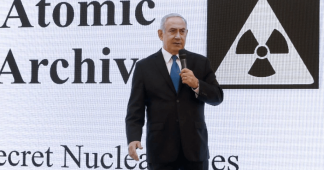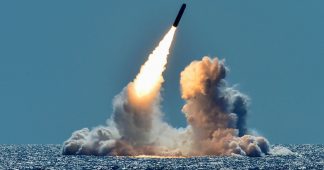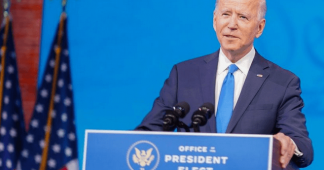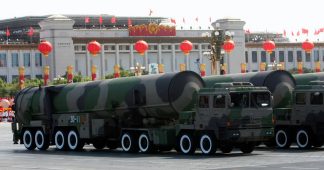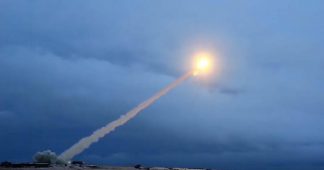Jun 14, 2021
(Stockholm, 14 June 2021) The Stockholm International Peace Research Institute (SIPRI) today launches the findings of SIPRI Yearbook 2021, which assesses the current state of armaments, disarmament and international security. A key finding is that despite an overall decrease in the number of nuclear warheads in 2020, more have been deployed with operational forces.
Signs that decline in nuclear arsenals has stalled
The nine nuclear-armed states—the United States, Russia, the United Kingdom, France, China, India, Pakistan, Israel and the Democratic People’s Republic of Korea (North Korea)—together possessed an estimated 13 080 nuclear weapons at the start of 2021. This marked a decrease from the 13 400 that SIPRI estimated these states possessed at the beginning of 2020 (see table below).
Despite this overall decrease, the estimated number of nuclear weapons currently deployed with operational forces increased to 3825, from 3720 last year. Around 2000 of these—nearly all of which belonged to Russia or the USA—were kept in a state of high operational alert.
While the USA and Russia continued to reduce their overall nuclear weapon inventories by dismantling retired warheads in 2020, both are estimated to have had around 50 more nuclear warheads in operational deployment at the start of 2021 than a year earlier. Russia also increased its overall military nuclear stockpile by around 180 warheads, mainly due to deployment of more multi-warhead land-based intercontinental ballistic missiles (ICBMs) and sea-launched ballistic missiles (SLBMs). Both countries’ deployed strategic nuclear forces remained within the limits set by the 2010 Treaty on Measures for the Further Reduction and Limitation of Strategic Offensive Arms (New START), although the treaty does not limit total nuclear warhead inventories.
‘The overall number of warheads in global military stockpiles now appears to be increasing, a worrisome sign that the declining trend that has characterized global nuclear arsenals since the end of the cold war has stalled,’ said Hans M. Kristensen, Associate Senior Fellow with SIPRI’s Nuclear Disarmament, Arms Control and Non-proliferation Programme and Director of the Nuclear Information Project at the Federation of American Scientists (FAS). ‘The last-minute extension of New START by Russia and the USA in February this year was a relief, but the prospects for additional bilateral nuclear arms control between the nuclear superpowers remain poor.’
Russia and the USA together possess over 90 per cent of global nuclear weapons. Both have extensive and expensive programmes under way to replace and modernize their nuclear warheads, missile and aircraft delivery systems, and production facilities.
‘Both Russia and the USA appear to be increasing the importance they attribute to nuclear weapons in their national security strategies,’ said Kristensen.
Other nuclear-armed states investing in future capabilities
All the other seven nuclear-armed states are also either developing or deploying new weapon systems or have announced their intention to do so. The UK’s ‘Integrated Review of Security, Defence, Development and Foreign Policy’, published in early 2021, reversed a policy of reducing the country’s nuclear arsenal and raised its planned ceiling for nuclear weapons from 180 to 260.
China is in the middle of a significant modernization and expansion of its nuclear weapon inventory, and India and Pakistan also appear to be expanding their nuclear arsenals.
North Korea continues to enhance its military nuclear programme as a central element of its national security strategy. While it conducted no nuclear test explosions or long-range ballistic missile tests during 2020, it continued production of fissile material and development of short- and long-range ballistic missiles.
‘The entry into force of the Treaty on the Prohibition of Nuclear Weapons in early 2021 highlights the growing divide between the nuclear-armed states, which are all investing in the long-term future of their nuclear forces, and other countries that are impatient to see progress on nuclear disarmament promised by the Nuclear Non-Proliferation Treaty,’ said Matt Korda, Associate Researcher with SIPRI’s Nuclear Disarmament, Arms Control and Non-proliferation Programme and Research Associate with the FAS Nuclear Information Project.
World nuclear forces, January 2021
| Country | Deployed warheads* | Other warheads** | Total 2021 | Total 2020 |
| USA | 1 800 | 3 750 | 5 550 | 5 800 |
| Russia | 1 625 | 4 630 | 6 255 | 6 375 |
| UK*** | 120 | 105 | 225 | 215 |
| France | 280 | 10 | 290 | 290 |
| China | 350 | 350 | 320 | |
| India | 156 | 156 | 150 | |
| Pakistan | 165 | 165 | 160 | |
| Israel | 90 | 90 | 90 | |
| North Korea**** | … | [40–50] | [40–50] | [30–40] |
| Total | 3 825 | 9 255 | 13 080 | 13 400 |
Source: SIPRI Yearbook 2021.
*‘Deployed warheads’ refers to warheads placed on missiles or located on bases with operational forces.
**‘Other warheads’ refers to stored or reserve warheads and retired warheads awaiting dismantlement.
***The British Government declared in 2010 that its nuclear weapon inventory would not exceed 225 warheads. SIPRI estimates that the inventory remained at that number in Jan. 2021. This is a revision of previous SIPRI assessments based on new information. A planned reduction to 180 warheads by the mid 2020s was ended by a government review undertaken in 2020 and published in early 2021. The review introduced a new ceiling of 260 warheads.
****The figures for North Korea are SIPRI’s estimates of the number of warheads that North Korea could potentially build with the amount of fissile material it has produced. There is no publicly available evidence that North Korea has produced an operational nuclear warhead for delivery by an intercontinental-range ballistic missile, but it might have a small number of warheads for medium-range ballistic missiles. The figures for North Korea are highly uncertain and are not included in the global totals.
Notes: All estimates are approximate. SIPRI revises its world nuclear forces data each year based on new information and updates to earlier assessments. The figures for Russia and the USA do not necessarily correspond to those in their 2010 Treaty on Measures for the Further Reduction and Limitation of Strategic Offensive Arms (New START) declarations because of the treaty’s counting rules. Global totals are rounded to the nearest 5 warheads.
A mixed outlook for global security and stability
The 52nd edition of the SIPRI Yearbook reveals some negative and some hopeful developments in 2020.
‘Despite outbreaks of conflict, rising military spending and of course the first year of a devastating global pandemic, overall global human security did not continue to deteriorate in 2020. The year’s crumbs of comfort included a significant drop in the number of people who died in armed conflicts around the world. Unlike previous years, the international arms trade did not expand. And the Climate Action Summit made some notable—if still insufficient—progress on climate goals,’ said SIPRI Director Dan Smith.
In addition to its detailed coverage of nuclear arms control and non-proliferation issues, the latest edition of the SIPRI Yearbook includes insight on developments in conventional arms control in 2020; regional overviews of armed conflicts and conflict management; in-depth data and discussion on military expenditure, international arms transfers and arms production; and comprehensive coverage of efforts to counter chemical and biological security threats.
For editors
The SIPRI Yearbook is a compendium of cutting-edge information and analysis on developments in armaments, disarmament and international security. Four major SIPRI Yearbook 2020 data sets were pre-launched in 2020–21: total arms sales by the top 25 arms-producing companies (December 2020), international arms transfers (March 2021), world military expenditure (April 2021) and trends in multilateral peace operations (May 2021). The earlier releases are available at www.sipri.org/media/pressreleases. The SIPRI Yearbook is published by Oxford University Press. Learn more at www.sipriyearbook.org.
Media contacts
For information and interview requests contact, Alexandra Manolache, SIPRI Communications Officer (alexandra.manolache@sipri.org, +46 766 286 133), or Stephanie Blenckner, SIPRI Communications Director (blenckner@sipri.org, +46 8 655 97 47).
Published at sipri.org
